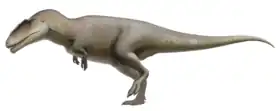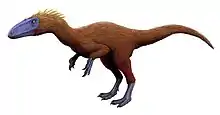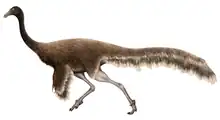Appalachiosaurus
Appalachiosaurus (/ˌæpəˌleɪtʃioʊˈsɔːrəs/ AP-ə-LAY-chee-oh-SOR-əs; "Appalachian lizard") is a genus of basal eutyrannosaurian theropod dinosaur from the middle Campanian age of the Late Cretaceous period of what is now eastern North America. Like all theropods, it was a bipedal predator. Only a juvenile skeleton has been found, representing an animal approximately 6.5 metres (21 ft) long and weighing 623 kilograms (1,373 lb), which indicates an adult would have been significantly larger. It is the most completely known theropod from eastern North America.
| Appalachiosaurus Temporal range: Late Cretaceous, | |
|---|---|
 | |
| Reconstructed skeleton, Tellus Science Museum | |
| Scientific classification | |
| Domain: | Eukaryota |
| Kingdom: | Animalia |
| Phylum: | Chordata |
| Clade: | Dinosauria |
| Clade: | Saurischia |
| Clade: | Theropoda |
| Clade: | †Eutyrannosauria |
| Genus: | †Appalachiosaurus Carr et al., 2005 |
| Species: | †A. montgomeriensis |
| Binomial name | |
| †Appalachiosaurus montgomeriensis Carr et al., 2005 | |
Fossils of Appalachiosaurus were found in central Alabama’s Demopolis Chalk Formation. This formation dates to the middle of the Campanian age of the Late Cretaceous, around 77 million years ago.[1] Fossil material assigned to A. montgomeriensis is also known from the Donoho Creek and Tar Heel-Coachman formations of North and South Carolina.[2]
Discovery and naming
The type specimen was found by Auburn University geologist David King in July 1982.[3] This dinosaur was named after the region of the eastern United States known as Appalachia, which also gave its name to the ancient island continent where Appalachiosaurus lived. Both are named after the Appalachian Mountains. The generic name also includes the Greek word sauros ("lizard"), the most common suffix used in dinosaur names. There is one known species, A. montgomeriensis, which is named after Montgomery County, Alabama. Both the genus and species were named in 2005 by paleontologists Thomas Carr and Thomas Williamson.
Description

The juvenile specimen of Appalachiosaurus measures approximately 6.5 m (21 ft) long and 623 kg (1,373 lb).[1][4] So far, it is only known from partial remains, including parts of the skull and lower jaw, as well as several vertebrae, parts of the pelvis, and most of both legs. These remains are housed at the McWane Science Center in Birmingham, Alabama. There are several open sutures between bones of the skull, indicating that the animal was definitely a juvenile. Several of its bones are crushed, but the specimen is still informative and shows many unique characteristics. Several of these have been identified in the skull and the foot claws show an unusual protrusion on the end closest to the body. A row of six low crests lines the top of the snout, similar to those of the Asian Alioramus, although most tyrannosaur species exhibit ornamentation to varying degrees on top of their snout and brows. The only remains found are from a juvenile, meaning that the size and weight of an adult is unknown. Appalachiosaurus is significantly different and more derived than another eutyrannosaur from eastern North America, Dryptosaurus.
The arms of Appalachiosaurus are poorly known. Large tyrannosaurids are characterized by proportionally small arms and hands with two functional fingers. Although some reports of a humerus are ascribed to Appalachiosaurus, no arm material is actually known.[5] Early reconstructions gave it long arms with three large fingers, but they are now thought to have been much shorter and have only two fingers. Museum mounts have been corrected accordingly, though other locations still support the former theory.[6] Appalachiosaurus had a bone-crushing bite force of around 32,500 newtons, or 7,193 pounds per square inch. [7]
Classification

The only known specimen of Appalachiosaurus was complete enough to be included in phylogenetic analyses using cladistics. The first was performed before the animal had even been named and found Appalachiosaurus to be a member of the Albertosaurinae subfamily of Tyrannosauridae, which only includes Albertosaurus and Gorgosaurus.[8] The original description also included a cladistic analysis, finding A. montgomeriensis to be a basal tyrannosauroid outside of Tyrannosauridae.[1] However, Asian tyrannosaurs, like Alioramus and Alectrosaurus, were excluded, as was Eotyrannus from England. Earlier tyrannosaurs, such as Dilong and Guanlong, had not been described at the time this analysis was performed. These exclusions may have a significant effect on the phylogeny.
Below is a cladogram published in 2013 by Loewen et al..[9]
| |||||||||||||||||||||||||||||||||||||||||||||||||||||||||||||
Possible pathology
Two vertebrae of the tail were found to be fused together, which is possibly a result of new bone growth following some sort of minor or traumatic injury.[1]
See also
References
- Carr, T.D.; Williamson, T.E.; Schwimmer, D.R. (2005). "A new genus and species of tyrannosauroid from the Late Cretaceous (middle Campanian) Demopolis Formation of Alabama". Journal of Vertebrate Paleontology. 25 (1): 119–143. doi:10.1671/0272-4634(2005)025[0119:ANGASO]2.0.CO;2. S2CID 86243316.
- Brownstein, Chase D. (2018-02-08). "The biogeography and ecology of the Cretaceous non-avian dinosaurs of Appalachia". Palaeontologia Electronica. 21 (1): 1–56. doi:10.26879/801. ISSN 1094-8074.
- "Appalachiosaurus montgomeriensis - Australian Museum". Archived from the original on 2014-01-04. Retrieved 2014-01-04.
- Ji, Q.; Ji, S.-A.; Zhang, L.-J. (2009). "First large tyrannosauroid theropod from the Early Cretaceous Jehol Biota in northeastern China" (PDF). Geological Bulletin of China. 28 (10): 1369–1374. Archived from the original (PDF) on 1 October 2018.
- Jovanelly, T.J.; Lane, L. (2012). "Comparison of the Functional Morphology of Appalachiosaurus and Albertosaurus". The Open Geology Journal. 6: 65–71. doi:10.2174/1874262901206010065.
- "The Daily Tribune News - Tellus Appalachiosaurus to receive shorter arms Friday". Archived from the original on 2013-02-28. Retrieved 2013-04-26.
- Jovanelly, Tamie J.; Lane, Lesley (September 2012). "Comparison of the Functional Morphology of Appalachiosaurus and Albertosaurus". The Open Geology Journal. 6 (1): 65–71. doi:10.2174/1874262901206010065.
- Holtz, T.R. (2004). "Tyrannosauroidea." In: Weishampel, D.A., Dodson, P., & Osmolska, H. (Eds.). The Dinosauria (2nd Edition). Berkeley: University of California Press. Pp. 111–136.
- Loewen, M.A.; Irmis, R.B.; Sertich, J.J.W.; Currie, P. J.; Sampson, S. D. (2013). Evans, David C (ed.). "Tyrant Dinosaur Evolution Tracks the Rise and Fall of Late Cretaceous Oceans". PLoS ONE. 8 (11): e79420. doi:10.1371/journal.pone.0079420. PMC 3819173. PMID 24223179.

.jpg.webp)












